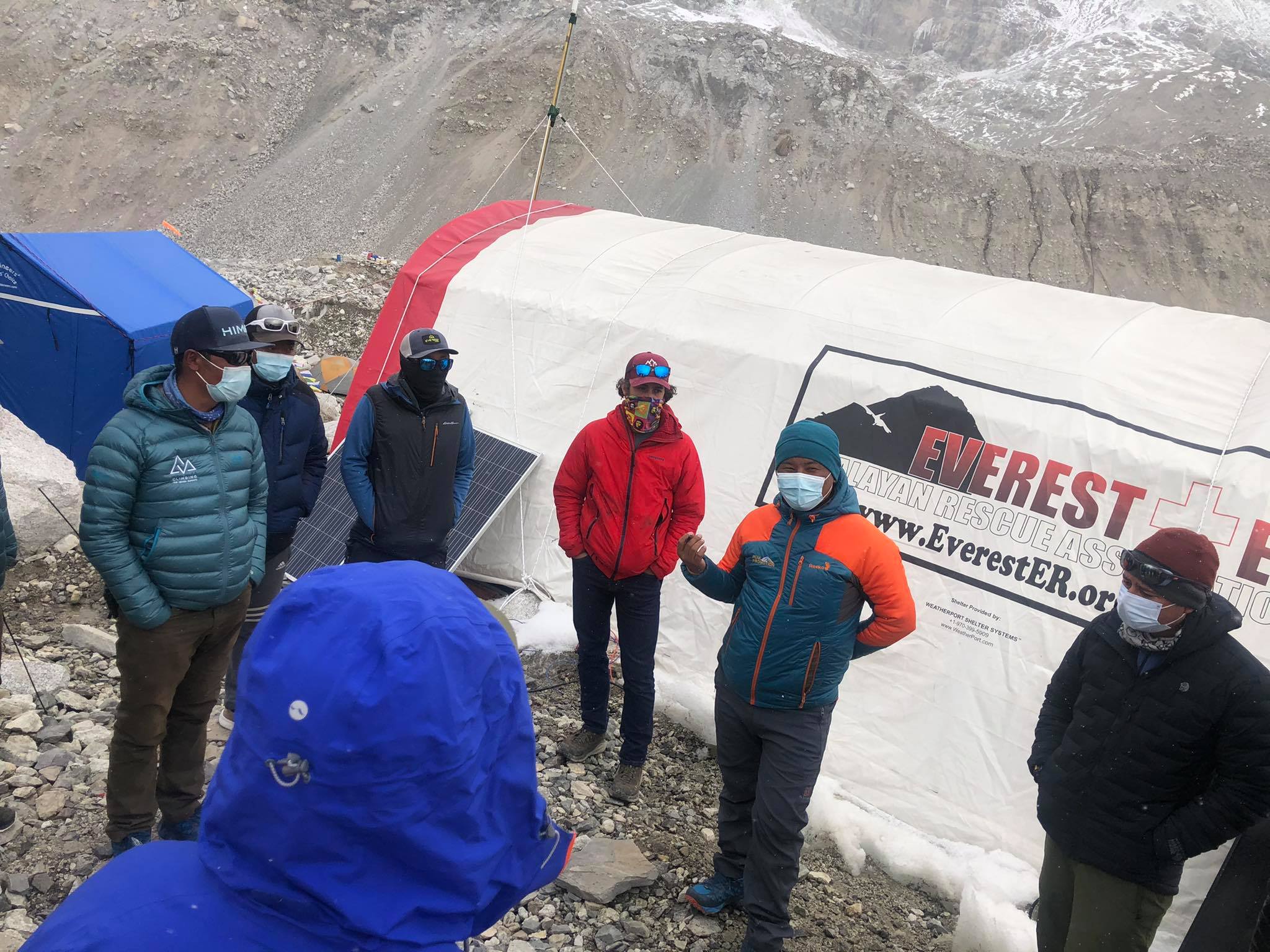It seems likely that COVID, not the monsoon, will end this year’s climbing season on Everest.
Spiking COVID numbers have forced authorities to lock down Nepal, as in 2020. On Everest, teams hurry to notch their summits before they are forcibly evacuated. But that could be in days, or hours.
At Everest Base Camp, COVID cases continue to spread, though not regularly. Some teams remain COVID-free, while others reportedly have many cases, prompting urgent measures from the Himalayan Rescue Association medical team.
COVID sweeps Nepal
This latest wave of COVID infections has struck Nepal hard. Skyrocketing case numbers have overwhelmed the hospitals. In Kathmandu, the lockdown is now in full effect, but Kathmandu alone still had 3,500 new cases yesterday, ExWeb correspondent Shashwat Pant reports.
PCR tests show a 43 percent positivity rate, the highest in Nepal during this pandemic, according to The Nepali Times. The situation is especially dire in towns bordering India and in the densely populated Kathmandu Valley.

Kathmandu’s Tribhuvan International Airport. Photo: The Nepali Times
As a result, the government has decided to stop all flights, both international and domestic (except for a link with Delhi twice a week), starting on Tuesday at midnight. We don’t know how this measure will affect trekking and climbing groups currently in Nepal. Everest expeditions can use helicopters to return to Kathmandu. But once there, it is not clear how they will return home.
The circumstances now resemble last year’s: Some climbers who did not flee the country quickly enough, such as Peter Hamor, Horia Colibasanu, and Marius Gane, had to remain in a locked-down Kathmandu for weeks. These three climbers are currently on Dhaulagiri’s NW Ridge and could find themselves stranded again.
Everest’s unsustainable situation
Meanwhile, at Everest Base Camp, the overall situation has not improved. Some religiously follow safety protocols and have kept their teams COVID-free, while others are far from safe.
“We hear about the [COVID] cases only from the media as our team is totally isolated,” Lukas Furtenbach told ExplorersWeb. “We have no contact at all with other teams.”
Furtenbach has also regularly tested both clients and staff, even during their trek into EBC. “We use COVID-19 antigen rapid test kits,” Furtenbach said. “We have our own doctor, and most team members are vaccinated.”
Some outdoor media, including ExplorersWeb, have received anonymous messages purportedly from Base Camp saying that a certain team has many cases of COVID and that several of their members have already been evacuated — yet the team still intends to climb to higher camps. As everyone clusters around the fixed ropes, it may be difficult to avoid other teams on the upper slopes of Everest.
Doctors particularly fear the onset of COVID symptoms in a previously asymptomatic climber at Camp 2 or higher. The stress of altitude could trigger a fast development of the illness and require a riskier rescue. Helicopters may be less available without domestic flights, and hospitals in Kathmandu are full.
Expedition leaders held a meeting today with the medical staff of the Himalayan Rescue Association at Base Camp. Doctors reemphasized the need to avoid camp-to-camp interactions and the need to use face masks even inside one’s own camp. “Suspected COVID cases are to be sent to Everest ER clinic for evacuation,” the Nepal News blog reported.
The public turns against “selfish tourists”
On Saturday, a climber was airlifted from Camp 2 with symptoms of High Altitude Cerebral Edema, according to Hungarian Journalist Laszlo Pinter. Apart from this legitimate use, helicopters are flying daily between Base Camp and Camp 2. But why? They are not rescue missions. A rather upset Elia Saikaly points out that these are simply designed to get climbers safely to C2 without having to deal with the Khumbu Icefall! There were nine such flights last week.
“Why climb when you can fly?” Saikaly said cuttingly in his Instagram post, which included a video of one flight. “You know who you are.”
The route through the Icefall, by the way, was closed yesterday after part of a serac fell, blocking the way and injuring two climbers.
Judging from comments, the public is increasingly pushing back against “selfish tourists”, “spreading the virus”, and “sipping O2 so badly needed in the country’s hospitals”.
COVID spreading down Khumbu Valley?
Petro Shamborovkyi and Oleg Ivanchenko of Ukraine spoke to ExplorersWeb from Namche Bazaar. They stopped here for two days after summiting Ama Dablam and want to do Lhotse without O2 next.
Now, given the uncertain and fast-changing situation, they aren’t sure what to do. Many climbers and trekkers have given up their plans and are trying to rebook their flights home, they said. In Namche, people wear masks, and they have started hearing about some cases.
Dhaulagiri: summit or leave?
Besides Everest, Dhaulagiri is currently the busiest 8,000m peak. Most climbers have spent acclimatization time at Camp 1 and/or Camp 2. They are ready for a summit push as soon as the weather clears.
Snow has fallen on Dhaulagiri every afternoon, but conditions should improve this week. If so, look for a massive summit push. Carla Pérez and Estaban Mena are also prepped for a fast, no-O2 ascent.
COVID seems not to have touched Dhaulagiri Base Camp yet. At least, no reports have appeared. But Pokhara is also in lockdown. Dhaulagiri climbers will also find it hard to return home if flights stop completely.

Climbers progress toward Camp 1 on Dhaulagiri. Photo: Carlos Soria






